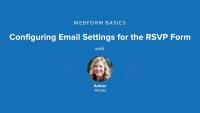In this lesson we'll add spam protection to our webforms using Honeypot module. We'll also take a second look at setting submission limits as a strategy for thwarting form submission abuse.
Additional resources
Introducing the Honeypot form spam protection module for Drupal
In this lesson, we'll explore the Results tab of our webform where we can view user submissions, get a basic analysis of our data, view the results as a table, download the results as a delimited text or Excel file, and clear all results.
Amber wraps up the series and takes a look back at what we covered in Webform Basics — from downloading and installing Webform module to building our form to analyzing the results.
Your First RESTful View in Drupal 8
Blog postIn a continuation from my first post, "An Introduction to RESTful Web Services in Drupal 8", I now want to explore how Views interacts with REST in Drupal 8. Please join me!
Drupalize.Me Podcast Episode 35
Blog postIn this week's episode, Object Oriented PHP, I'm joined by Lorna Jane Mitchell and Joe Fender to step outside of Drupal a little and look at the larger PHP landscape.
Media Explained: A Free Acquia Webinar
Blog postPictures. Podcasts. Videos. If you've ever tried to incorporate rich media files into your web site using only Drupal core, you probably got a shiver down your spine when I said that. Fortunately there is a solution.
Our New Project Management Process
Blog postAt the end of last year, our team outlined our goals for 2014 and reviewed our internal processes. We devised a new plan for managing our site development, and it has proven quite successful.
This week, as we continue our Webform Basics series, I walk through the many settings of the Webform module. I cover email settings, form settings, and global Webform settings. All of which will help make your form behave exactly how you want it!
In this lesson, we'll get a grasp on the form settings of our webform node. We'll explore submission settings, form access by role, and advanced settings and we'll take a quick look at some of the contexts in which these advanced settings apply, for example multipage forms.
In this lesson, we'll go over Webform's Global Settings. We'll learn how to attach forms and questionnaires to other content types besides the Webform content type. We'll discover how we can limit the list of available form components, set email header defaults, and take a look at the advanced options in Webform's global configuration.
Note: Webform settings are no longer set globally as described in this video. Instead you configure settings per content type. Go to Structure > Content Types and select the content type to edit. You can enable Webform for a content type in its edit form.
In this lesson, we'll configure email settings for the RSVP form. We'll go over the different email header options and customize the default message template, using special tokens that Webform module provides.
Catching the Community Train
Blog postGetting involved in any community on a professional or personal level can be intimidating at first. How do you add value and contribute to something that already has so much community involvement, innovation, and growth? It’s easy to feel like you're trying to catch a runaway train.
Recent Site Updates
Blog postOver the last few weeks, we've made several updates to the site. Most of these updates were backend and infrastructure tweaks, which help us provide the smooth service you've come to expect. But we've made also some notable user-facing improvements. Curious to learn more?
Webform Basics
CourseNow that we've created a webform node for our form to live, it's time to build the form itself and add the form fields that we'll use to collect responses. In this lesson, we'll add a textfield, select options and number inputs. We'll begin by taking a closer look at the webform in its final state to better understand where we're going, then we'll return to the webform node we created in lesson 2 and we'll add each form component, step-by-step.
this lesson, we'll configure Webform content type defaults and add our first Webform node.
Additional resources
In this series, Amber will show you how she gathered her wedding invitation responses on a Drupal site using Webform module. You'll learn how to:
- Collect data from users
- Build common types of form fields (including text fields, numeric inputs, and radio button option lists)
- View, export, and analyze those responses
- Automatically email responses as they're submitted
Understanding the basics of Webform empowers you to create your own custom forms such as surveys, feedback forms or your very own RSVP form. Dive in and learn the basics of Webform.
Configuration Management for Developers
Blog postIn an earlier post, Kyle wrote a great introduction to the new configuration management system in Drupal 8. He demonstrated how end users can leverage this new system to easily migrate site configuration between environment, which helps eliminate the "did you remember to check the boxes in the right order?" problem for site builders everywhere. In this post, I take a look at configuration management from the perspective of a module developer. What do we need to write in our custom code to ensure that our configuration settings are easy to deploy?
Drupalize.Me Podcast Episode 34
Blog postIn our podcast episode 34, Kyle is joined by Kevin Colligan, Sr. Director/Head of Digital Media for the GRAMMY Awards, and Nate Haug, Senior Drupal Architect at Lullabot, to discuss how GRAMMY.com is powered by Drupal.
This week we continue our learning series, Working with Media Module in Drupal 7. In these lessons, Addison explains the many considerations of managing media in a content management system, how you can use Drupal and the Media module to manage and display all kinds of media, and how you can utilize images in several different ways. If you've been wondering how to place images using a WYSIWYG editor or how to create a gallery, these are the lessons you've been waiting for.








